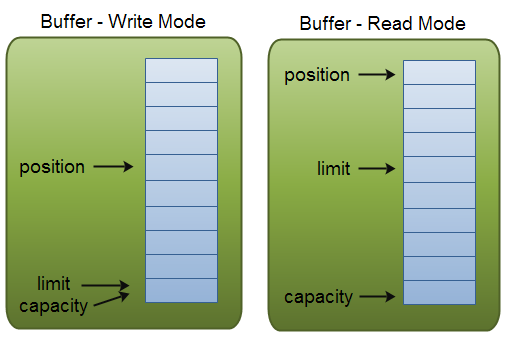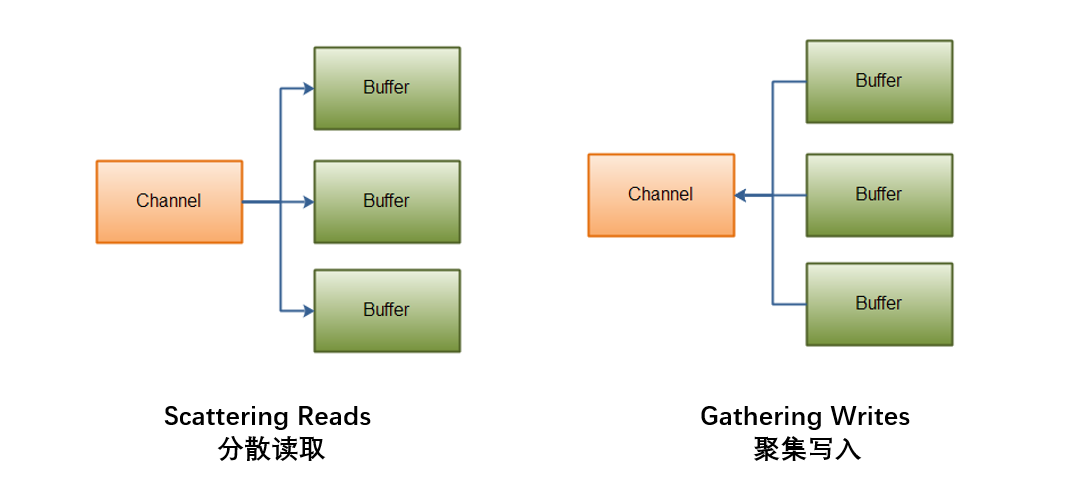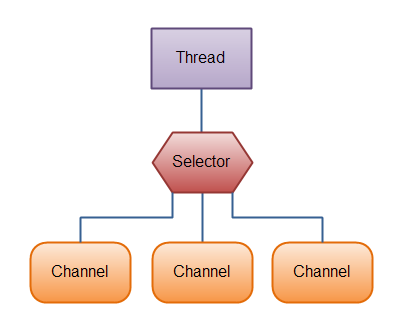Java简明笔记(十五)Java NIO
什么是 Java NIO
Java NIO, N 可以理解为 New ,也可以理解为 Non-blocking ,是 Java 1.4 之后新的一套区别于标准 Java IO 和 Java Networking 的 API 。NIO 跟传统的 BIO 之间最大的区别在于 NIO 是面向 Channels 和 Buffers 的,一个线程可以通过 Selector 管理多个 Channels ,继而管理多个连接,在线程进行 IO 操作时不会阻塞。
面向 Channels 和 Buffers
普通的IO,面向的是 byte streams(字节流,如FileOutputStream) 和 character streams(字符流,如FileReader),但是 NIO 面向的是 channels 和 buffers 。对于 Channel 来说,数据总是从 channel 写进 buffer 里,然后 Java 从 buffer 取出使用,或者 channel 读 buffer 里的数据,传输到外界。

Channel 有点像流(Stream),在 Java NIO 中,有以下几种 channel:
- FileChannel
- DatagramChannel (用于通过 UDP 读写数据)
- SocketChannel (用于通过 TCP 读写数据)
- ServerSocketChannel
而 Buffer 就是我们熟悉的缓冲区了。包括:
- ByteBuffer
- CharBuffer
- DoubleBuffer
- FloatBuffer
- IntBuffer
- LongBuffer
- ShortBuffer
- MappedByteBuffer(不展开讲)
一个线程,可以让 channel 把数据读进 buffer 中(操作者是 channel ),当 channel 正在读的时候,线程可以做其他事。一旦数据已经读进 buffer 了,线程可以回来处理这些数据。写的情况也是类似。
一个简单的例子
Channel 和 Buffer 配合的工作流程如下:
- 开一个文件
- 获取 Channel
- 设置 buffer
- 让 Channel 将数据读到 buffer 里
- 数据进入 buffer
- 调用
buffer.flip() - 数据从 buffer 出去
- 调用
buffer.clear()或 buffer.compact()
// RandomAccessFile 可以自由读写文件的任意位置,不继承字节流或字符流
// 1. 开一个文件
RandomAccessFile aFile = new RandomAccessFile("data/nio-data.txt", "rw");
// 2. 获取 Channel
FileChannel inChannel = aFile.getChannel();
// 3. 设置 buffer,由于我们要读字节,因此是 ByteBuffer
ByteBuffer buf = ByteBuffer.allocate(48);
// 4. 利用 Channel 将数据读到 buffer 里
int bytesRead = inChannel.read(buf);
while (bytesRead != -1) {
System.out.println("Read " + bytesRead);
buf.flip();
while(buf.hasRemaining()){
System.out.print((char) buf.get());
}
buf.clear();
bytesRead = inChannel.read(buf);
}
aFile.close();注意:
buf.flip()的作用:当你想从 buffer 里获取数据,应该调用 flip 方法。调用这个方法的时候,buffer 将会从 数据写入模式 切换到 数据读出模式buf.clear()的作用:当数据全部从 buffer 读出去了,应该调用 clear 或 compact 方法,好让 buffer 重写可以写入。 这两个方法的区别是:clear清除整个缓冲区,compact只清除已经读过的部分。
Capacity, Position 和 Limit
buffer 实际上是一块内存区域可以让你往里面写数据,之后再读到程序里。这块内存区域包含在一个 NIO Buffer 对象里。
在 buffer 中,有 Capacity, Position 和 Limit 这三个概念。position 跟 limit 跟 buffer 是读模式还是写模式有关,而 Capacity 与模式无关。

Capacity
顾名思义,Capacity 就是容量。也就是 buffer 缓冲区最多能存储多少 bytes (或者 longs,或 chars ,取决于何种类型的 buffer )
Position
当你往 buffer 里写一个单位的数据的时候, position 就 +1, position是当前位置指示器。最大值为 Capacity - 1。
当你从 buffer 里读数据时,同样有一个 position 指示器。当调用 flip ,让 buffer 从写模式转换成读模式的时候, position 会被重置为 0
limit
在 buffer 写模式中, limit 等于 capacity,决定了你能往 buffer 里写多少数据。
在 buffer 读模式中,limit 告诉你缓冲取最多有多少数据可以让你读取。也就是说,一开始写模式写了多少数据,会记录在 position 中,一旦你调用 flip 切换到读模式,limit 就是刚刚的 position。
Buffer 的方法
flip
当调用 flip方法, position 会被置0,然后 buffer 会切换模式(读->写,或 写->读),limit 也随之改变。
rewind
rewind 可以让 position 变为 0, 好让你重新读刚刚读过的数据,但是模式不变。limit 的值也不会变。
clear() 和 compact()
clear清除整个缓冲区,compact只清除已经读过的部分。如果你有一些数据还没读,使用 compact, compact 会把未读的数据放到起始位置,然后把 position 放到最后一个数据的右边。

mark() 和 reset()
可以用 mark 方法标记 position,然后做一个其他事后,调用 reset, position 会回到刚刚标记的位置。
Scatter(分散) / Gather(聚集)
channel "scatters" 是指,多个 buffer 从一个 Channel 里读取数据。分散读取是以数组的形式,总是先填充前面的 buffer,这意味着不支持动态大小。
ByteBuffer header = ByteBuffer.allocate(128);
ByteBuffer body = ByteBuffer.allocate(1024);
ByteBuffer[] bufferArray = { header, body };
channel.read(bufferArray);
channel "gathers" 是指,多个 buffer 把数据写进一个 Channel。如果一个 ByteBuffer 的 capacity 有128字节,但实际只存储了58字节。Gather 只会往 channel 里写这58字节。然后继续写下一个。
ByteBuffer header = ByteBuffer.allocate(128);
ByteBuffer body = ByteBuffer.allocate(1024);
//write data into buffers
ByteBuffer[] bufferArray = { header, body };
channel.write(bufferArray);在不同 Channel 之间转换
Channel 之间可以互相转换,以 FileChannel 为例,提供了 transferFrom() 和 transferTo() 方法。
RandomAccessFile fromFile = new RandomAccessFile("fromFile.txt", "rw");
FileChannel fromChannel = fromFile.getChannel();
RandomAccessFile toFile = new RandomAccessFile("toFile.txt", "rw");
FileChannel toChannel = toFile.getChannel();
long position = 0;
long count = fromChannel.size();
// 从其他channle转到FileChannel
toChannel.transferFrom(fromChannel, position, count);
// 从FileChannel转到其他channle
fromChannel.transferTo(position, count, toChannel);在有些 SocketChannel 的实现中,只会转换 channel 当前有的数据(尽管稍后 SocketChannel 会传来更多数据,但会被忽略)
Selectors
Java NIO 有一个 "selectors" 的概念。 selector 可以监控多个 channels 事件的状态(例如,连接已建立,数据已到达等)。因此,只需一个线程即可管理多个 channels ,继而管理多个 connection。在并发量特别大时,传统的IO由于一个线程只负责一个连接,因此会创建大量线程。而用 NIO 的 selector,你甚至可以只用一个线程管理所有连接。
然而,不要一贯认为传统IO多线程就不好。我们总说操作系统在线程切换时有一定开销,然而现代CPU都是多核处理器,不用多线程相当于浪费。

channel.configureBlocking(false);
/*
第二个参数设置感兴趣的事件,可选项:
SelectionKey.OP_CONNECT
SelectionKey.OP_ACCEPT
SelectionKey.OP_READ
SelectionKey.OP_WRITE
*/
SelectionKey key = channel.register(selector, SelectionKey.OP_READ);
// 第三个参数设置附加对象(可选)
SelectionKey key = channel.register(selector, SelectionKey.OP_READ, theObject);使用 Selectors 的 channel 必须设置成 non-blocking 模式。FileChannel 无法设置成 non-blocking 因此无法使用 Selectors。 Socketchannels 则可以。channel.register 的第二个参数设定感兴趣的事件,如连接已建立、客户端accept,准备好可读,准备好可写。如果需要设定多个使用,用或语句。
int interestSet = SelectionKey.OP_READ | SelectionKey.OP_WRITE;register 之后会返回一个 SelectionKey,通过它来获取有用信息:
Channel channel = selectionKey.channel();
Selector selector = selectionKey.selector();
// 附加对象(可选)
selectionKey.attach(theObject);
Object attachedObj = selectionKey.attachment();select 方法
Selectors 的 select()方法用于返回准备好的 channel 数量。例如,你设置了若干个 SocketChannel 对 read 感兴趣。当你调用 select() ,将返回当前准备好可以读取数据的 channel 数量。
int select() // 若无,则阻塞
int select(long timeout) // 若无,超时时间内阻塞
int selectNow() // 立即返回当 select 返回大于0的数字,说明有 channel 准备好了,实际上内容封装在 Set<SelectionKey> 里,我们可以取出来然后做相应的动作。完整例子:
Selector selector = Selector.open();
channel.configureBlocking(false);
SelectionKey key = channel.register(selector, SelectionKey.OP_READ);
while(true) {
int readyChannels = selector.selectNow();
if(readyChannels == 0) continue;
Set<SelectionKey> selectedKeys = selector.selectedKeys();
Iterator<SelectionKey> keyIterator = selectedKeys.iterator();
while(keyIterator.hasNext()) {
SelectionKey key = keyIterator.next();
if(key.isAcceptable()) {
// a connection was accepted by a ServerSocketChannel.
} else if (key.isConnectable()) {
// a connection was established with a remote server.
} else if (key.isReadable()) {
// a channel is ready for reading
} else if (key.isWritable()) {
// a channel is ready for writing
}
keyIterator.remove();
}
}wakeup() 和 close()
调用 select() 方法的线程会阻塞,用另一个线程调用 Selector.wakeup() 方法可以让它立即返回。
调用Selector.close()可以关闭 Selector 和所有 SelectionKey ,但 channels 不会被关闭。
什么时候用 NIO,什么时候用传统 IO ?
NIO可以只使用一个(或几个)单线程管理多个通道(网络连接或文件),但付出的代价是解析数据可能会比从一个阻塞流中读取数据更复杂。
如果需要管理同时打开的成千上万个连接,这些连接每次只是发送少量的数据,例如聊天服务器,实现NIO的服务器可能是一个优势。同样,如果你需要维持许多打开的连接到其他计算机上,如P2P网络中,使用一个单独的线程来管理你所有出站连接,NIO可能是一个优势。
如果你只有少量的连接但是每个连接都占有很高的带宽,同时发送很多数据,传统的IO会更适合。
- 参考教程:java-nio
